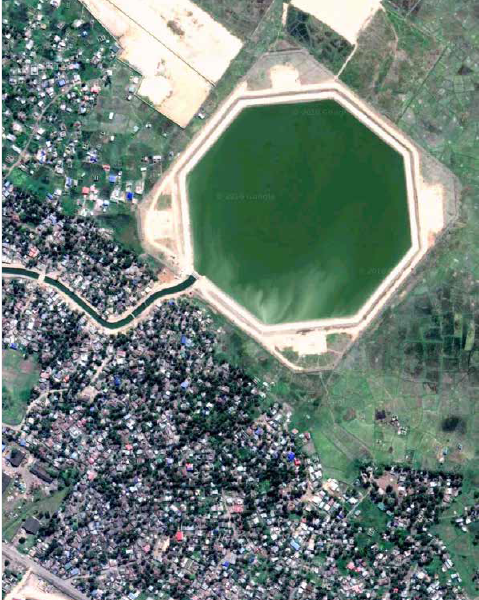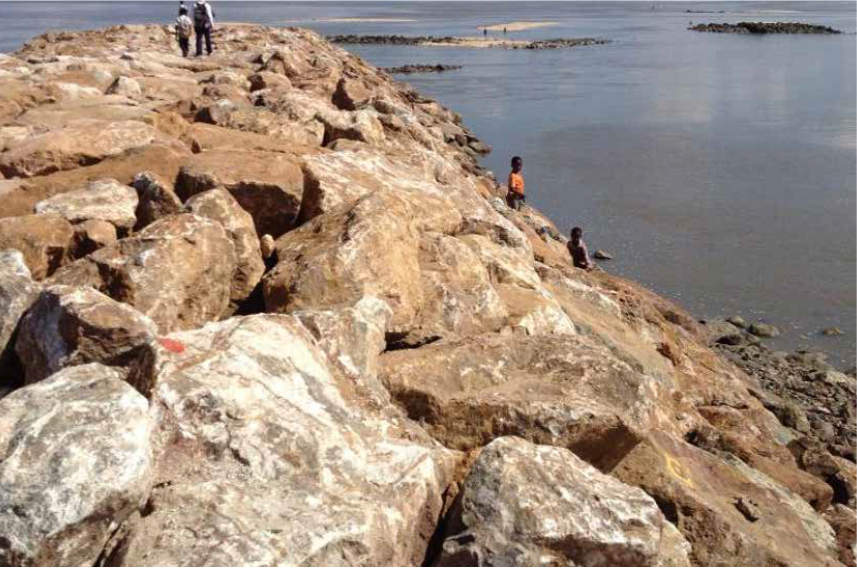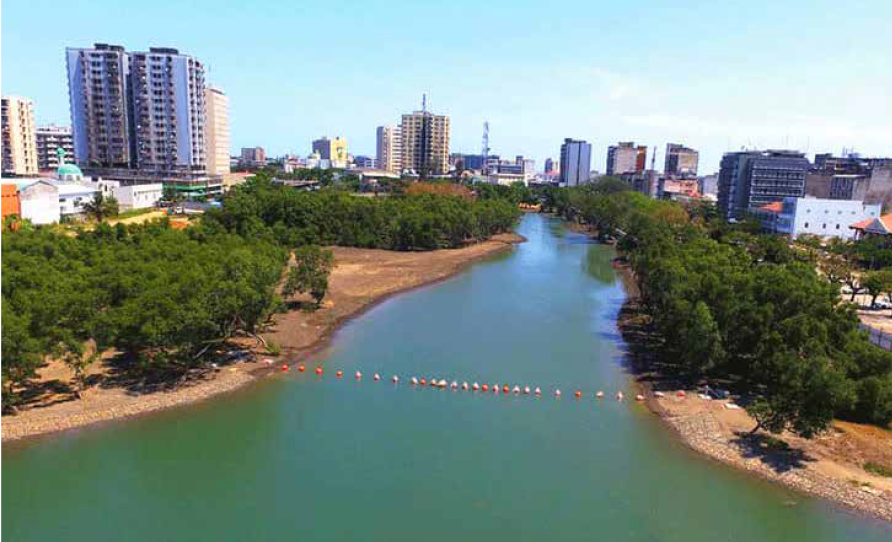A patient process-oriented approach in Beira, Mozambique
A patient process-oriented approach in Beira, Mozambique
Beira’s municipal government and the Netherlands have worked together since 2012 in a long-term partnership to support urban resilience. The partners made a conscious decision to focus on process, allowing strategies to emerge and adapt to changing contexts, rather than setting concrete objectives up front.
Two initiatives are especially relevant. The partners used the process of developing an urban master plan to bring together multiple stakeholders and leverage investment from international development finance institutions in drainage, coastal protection, and sanitation infrastructure.
And Beira set up an urban land-development company to invest and create opportunities for affordable, flood-resilient housing for the urban poor as well as catalyze the development of commercial and industrial areas to create jobs and facilitate private-sector investment.
Beira’s challenges, including lack of budget to operate and maintain physical infrastructure, insufficient institutional capacity, and political sensitivities, are shared by many low-lying coastal cities. A patient, process-oriented approach with a committed development partner can produce tangible results over time.
Urban sprawl, cyclone risks and decaying infrastructure
Beira is Mozambique’s fourth-largest city, with approximately 530,000 inhabitants. Like all the country’s cities, it is growing quickly—Mozambique’s urban population has more than doubled in the last 20 years74. Mozambique is, as per the World Bank, a low-income country, with around three-fifths of its 30 million people living below the US$1.90 per day poverty line75. It is among the African countries most vulnerable to climate change.
Beira was founded in 1890 as a station for trade and exploitation of natural resources and both its port and a railway line to Zimbabwe were established around then. Today the port is Mozambique’s second-largest, behind only the capital Maputo, and it handles international trade for Zimbabwe, Malawi, Zambia, Botswana, and DRC.
Much of the city of Beira—including the center—is built on the low-lying alluvium of the Pungue river, and is prone to flooding due to rainfall and invasion from the sea. Some of the lowest parts of the city are regularly inundated during spring tides. A dune strip of varying height offers coastal protection to other parts of the city, but only some small patches of mangrove remain along the coast—most disappeared decades ago.
Parts of the city are built on a higher plateau, with an elevation difference of at least five meters. However, the plateau is also flood-prone during high-rainfall events due to the low permeability of soils and the absence of effective drainage. Alongside more intense rainfall and rising sea levels, climate chang is threatening Beira by shifting the trajectory of tropical cyclones southwards. In March 2019, Cyclone Idai hit the city. High winds destroyed 70 percent of houses either partially or fully, roads and other infrastructure were damaged, and intense rainfall caused widespread flooding. Despite this, Idai was a narrow escape for Beira because it coincided with a neap tide—had it hit during a spring tide, when sea levels are 2.3 meters higher, the resulting storm surge would have almost totally inundated the city. Population pressure has increasingly led to urban sprawl.
Many urban poor have no alternative than to settle in low-lying, flood-prone areas; much of the land that people have informally settled in Beira in recent years is marshy lowland previously used for rice agriculture. This kind of land is not suitable for human habitation because it is a breeding ground for malaria and other diseases, and the public health hazards are known to be especially serious for children.
Economic activity is also increasing demands on land for industrial and commercial use. Expansion of the port’s activities has created pressure on roads, with frequent traffic jams of trucks. After decades of neglect, the railway is functioning only partly.
At the time of publication, Beira’s municipal government is in the hands of a different political party than the national government. FRELIMO has governed Mozambique since independence in 1975; Daviz Simango has been the Mayor of Beira since 2003, and now helms national opposition party MDM. Democratic cross-party co-operation is not yet well established in Mozambique, and this complex governance environment exacerbates challenges in service delivery and infrastructure investment, which is mostly funded by donors and channeled through central government.
The port and railway are under the control of Mozambique’s central government, as is the water supply: the port is largely operated by a private firm of mixed national and foreign capital, while the water supply and electricity services are in the hands of a national parastatal. Roads are the responsibility of the municipality, along with the drainage and sewage networks, and an important element of coastal protection.
However, the municipality has insufficient budget even to operate and maintain this decaying infrastructure, much of which dates from the pre-independence era, let alone repair or improve it. Its annual income from municipal taxes and central government endowments together amounts to approximately €15 million—less than 1 percent of the budget of a city of a similar number of inhabitants and physical challenges in Europe.
The intervention: A long-term development partnership
Beira’s municipal government and the Netherlands have worked together in an equal partnership since 2012 on a program to support urban resilience—that is, the capacity of a city to absorb shocks, continue to function, and recover quickly. The partnership’s broad aims include improving awareness of climate-change vulnerability and adaptation, the sustainability of development interventions, and coordination across institutions and levels of government to achieve and promote positive development outcomes for vulnerable Beira citizens.
 The partnership is long-term—intended to last for 15 years, with a mid-term review currently underway. It is wide-ranging and deliberately open-ended: both Beira and the Netherlands made a conscious choice to avoid setting concrete goals upfront, in an environment that is prone to constant and rapid change. Instead, they wanted to maintain maximum flexibility to respond to events and pursue priorities as they are identified by the municipality. In line with this, the partners started by developing an urban master plan that aimed to set out a vision of Beira’s future to 2035, though not a detailed blueprint.
The partnership is long-term—intended to last for 15 years, with a mid-term review currently underway. It is wide-ranging and deliberately open-ended: both Beira and the Netherlands made a conscious choice to avoid setting concrete goals upfront, in an environment that is prone to constant and rapid change. Instead, they wanted to maintain maximum flexibility to respond to events and pursue priorities as they are identified by the municipality. In line with this, the partners started by developing an urban master plan that aimed to set out a vision of Beira’s future to 2035, though not a detailed blueprint.
Two elements of this partnership are most relevant to this study.
![]() Facilitating investment in urban drainage, coastal protection, and sanitation.
Facilitating investment in urban drainage, coastal protection, and sanitation.
The process of developing the urban master plan created space for dialogue between the mayor and international financiers. This helped them to understand Beira’s particular needs—not only for social development, but also for creating an enabling environment for private-sector development.
As a result of this dialogue, Beira benefited from around US$ 60 million-worth of investment as part of the World Bank-financed Mozambique Cities and Climate Change Project. It rehabilitated 11 kilometers of drainage canals, installed flood control stations, and constructed a large water-retention basin. The project was completed by 2018 and during Cyclone Idai, the project demonstrated its effectiveness: areas with rehabilitated drainage experienced relatively less flooding.
Nonetheless, Idai also made starkly clear that the project would not be sufficient to safeguard the city against future cyclones—indeed, without further investment, disaster is only a matter of time. Because the partners had already analyzed Beira’s disaster risk exposure and preparedness, plans for additional adaptation measures and investments could be drawn up quickly.
In consequence, around another US$ 225 million of investment is now planned in drainage, sanitation and coastal protection, addressing various aspects of urban resilience. The Beira Urban Recovery and Resilience Plan was developed with the support of the Dutch Government, UNDP and UN-Habitat, and the funding comprises grants from the World Bank, the Netherlands, German co-operation through KfW and the European Union, coordinated at national level by the Ministry of Public Works and Housing.
![]() Creating an enabling environment for affordable, flood-resilient residential housing.
Creating an enabling environment for affordable, flood-resilient residential housing.
While this international funding is improving the climate resilience of flood-prone areas which have already been developed, for the future it is critical to change incentives to shift new development onto more suitable terrain, in alignment with Beira’s urban development plans.
In 2018, the municipality set up an urban land-development company, SDU Beira. It aims to create the space for new, affordable, flood-resilient residential housing close to the city center: 20,000 people are expected to live on the 400-hectare Maraza development, three hectares of which have been set aside for a fast-track pilot project.
In Mozambique, the state owns all land and people apply for rights to use it. The land assigned to SDU Beira had previously been used for subsistence agriculture. Several hundred smallholders have so far been resettled and have benefited from programs to restore families’ livelihoods in ways that aim to improve on international best practice on acquiring consent and providing compensation.
SDU Beira, with financial support from the Netherlands, is pre-investing in infrastructure such as drainage, roads, sewage, and landfill to raise the terrain level of the Maraza development. The overall goal is to offer plots or pre-constructed houses at prices that will be affordable even at the bottom of the pyramid. This will depend on achieving scale through a combination of efforts including:
- Cross-subsidization from commercial development. SDU Beira is working to establish 900 hectares of land for industrial and commercial development in connection with the port and the Beira corridor. Development is still in the planning stage. As well as attracting investors, enhancing economic activity and creating jobs—all goals in themselves—this should create funds to cross-subsidize the residential development.
- Working with banks to improve access to financing. It is effectively impossible for an ordinary person to get a mortgage in Mozambique, where the banking sector is traditional and risk-averse and interest rates are high; in a country of 30 million people, only 600 have a mortgage. Meanwhile, real-estate developers struggle to access finance to build affordable housing as local banks lack experience and development banks focus on larger-scale projects. By working to improve access to affordable finance for both developers and buyers, the partners aim to bring down prices significantly in the longer term.
- Improving the functioning of the municipal land registry. Clarifying the existence of land-use rights that could be used as collateral should help to create a better market for lending, contributing to a more enabling environment for private-sector development.
A consequence of the wide-ranging, open-ended nature of the partnership between Beira and the Netherlands is that many individual interventions serve multiple aims: the work to improve the land registry, for example, is also intended to make it easier to collect municipal property taxes, boosting budgets for sustainable operation and maintenance of critical infrastructure, such as the drainage and sewage infrastructure and coastal protection.
Four key learnings
The journey toward higher awareness of climate-change vulnerability, more sustainable development interventions, and better coordination at all institutional levels is challenging. The achievements of the partners so far—notably increased international investment in infrastructure and incremental improvements in the enabling environment—have inevitably come amid setbacks. That said, we can identify four key learnings from the intervention.
![]() 1. Building a long-lasting partnership means focusing on the journey, not the destination. The partners took the conscious, explicit decision from the start that the best chance of success came from a long-term commitment with a focus on process, rather than ‘big bang’ projects with concrete objectives set up front. They both aimed to create an equal partnership, with mutual inspiration and co-creation as key aspects.
1. Building a long-lasting partnership means focusing on the journey, not the destination. The partners took the conscious, explicit decision from the start that the best chance of success came from a long-term commitment with a focus on process, rather than ‘big bang’ projects with concrete objectives set up front. They both aimed to create an equal partnership, with mutual inspiration and co-creation as key aspects.
In particular, the process of developing the urban master plan in 2013-14 was just as important as the resulting document, which was approved in 2015 by the Municipal Assemblée. Developing a vision and articulating priorities jointly with stakeholders helped the city to engage people and institutions in a coherent framework of interventions. Annual thematic round tables brought together finance partners and national and municipal government entities. Investment conferences involved the private sector. These have become an important platform for dialogue and exchange, helping to coordinate and maintain momentum.
Taking a long-term perspective means there is scope to adapt when contexts change or new insights emerge—an important element in building urban resilience. This process of ‘strategy emergence’ involves the mayor taking leadership in the change process, the Netherlands Embassy playing the role of convener, a flexible budget for interventions, and a willingness to take risks.
SDU Beira is an example of strategy emergence: setting up an urban-development company was a stated wish of the municipality, but might not have happened without the partnership and its focus on building an enabling environment. The potential for synergy between SDU Beira and other efforts—such as to improve the land registry—also requires long-term vision and analytical work that goes beyond simple project interventions.
Cyclone Idai showed how the existence of a strong partnership can lead to a flexible response when contexts change: Beira acted rapidly and involved multiple international partners to draw up a municipal recovery and resilience plan and contribute to the national post-disaster needs assessment, thus building on their accumulated joint knowledge of the city. The convening role of the Netherlands Embassy helped to support other financiers to make substantial funds available.
![]() 2. Aiming for sustainable social inclusion at scale. The partnership between Beira and the Netherlands is rooted in the conviction that urban development can be successful only when it is equitable and creates sustainable improvements for people in the lower socio-economic strata.
2. Aiming for sustainable social inclusion at scale. The partnership between Beira and the Netherlands is rooted in the conviction that urban development can be successful only when it is equitable and creates sustainable improvements for people in the lower socio-economic strata.
Engaging people from such strata has proved to be a challenge. During the master-planning process in 2013 and 2014, it became clear that civil society is not well organized in Beira: grassroots organizations are few and they are often politicized. Moreover, people frequently have the experience that participation in such processes will not translate into positive change in their lives and access to services. In many low-income countries, the social contract between citizens and state is not strong; Mozambique is no exception.
In response to these challenges, it is critical to implement environmental and social-impact assessments professionally and independently, to promote the well-being of vulnerable people. When resettling smallholder farmers from the land assigned to SDU Beira, the partners not only secured their consent and provided compensation, but also enrolled the farmers or their relatives in vocational training courses to enable them to learn an alternative livelihood. People who have been resettled so far are mostly positive about their personal outcomes.
Ultimately, the only way to prevent urban sprawl into low-lying swamp areas is to create alternative settlement options that are affordable and more attractive—and the only way to do this sustainably and at scale is by developing initiatives that use the market economy to engage low-income people as customers, offering them socially beneficial products at prices they can afford. This sounds simple, but it will require systemic change to achieve.
The cheapest houses in Mozambique currently sell for upwards of US$ 40,000—well beyond the average person’s reach. SDU Beira has set itself the initial target of offering affordable, flood-secure residential units at around a quarter of this price: cross-subsidization, improved financing for both developers and buyers, new models such as rent-to-buy and economies of scale should all help to force prices lower over time.
![]() 3. Improving the capacity of municipal institutions. While international finance partners are funding the development of new flood-protection infrastructure—bringing immediate benefits for the urban poor, who have already settled on unsuitable marshland—the municipality will be able to maintain it only if it has well-functioning institutions with adequate budgets and sufficient, well-motivated professionals.
3. Improving the capacity of municipal institutions. While international finance partners are funding the development of new flood-protection infrastructure—bringing immediate benefits for the urban poor, who have already settled on unsuitable marshland—the municipality will be able to maintain it only if it has well-functioning institutions with adequate budgets and sufficient, well-motivated professionals.
The partnership between Beira and the Netherlands is working hard to put the foundations in place. Improving the land-registry database, for example, aims in part to make it easier to levy property taxes—a sustainable and substantial source of municipal income. Property owners perceive these taxes to be legitimate when they visibly fund improved drainage and flood protection.
Similarly, the municipality is working with the national water company to look at recovering sanitation costs through the fees paid as part of water bills. The partners have implemented various interventions to improve the professionalism of personnel, including as part of their work to build capacity in the land registry and urban planning department. Programs are being developed that focus on personal motivation of staff through the ‘field level leadership’ approach of the World Bank.
Other interventions focus on physical reorganization of departments, digitalization of land administration, and improving work processes and communication with civilians, all with the aim of improving the municipality’s performance toward its citizens.
![]() 4. Structuring for the best chance of political sustainability. Mayor Simango is widely recognized as a charismatic leader with the capacity to work across political dividing lines. Nonetheless, the political sustainability of interventions has needed as much careful thought as their economic sustainability.
4. Structuring for the best chance of political sustainability. Mayor Simango is widely recognized as a charismatic leader with the capacity to work across political dividing lines. Nonetheless, the political sustainability of interventions has needed as much careful thought as their economic sustainability.
SDU Beira was purposefully set up to be a politically neutral entity because the partners believe this gives it the best chance of helping to foster a more business-like environment for co-operation on development objectives which are shared by the municipality and central government. The aim was to find the right distance from the municipal government for SDU Beira to operate: a publicly owned company rather than a municipal department, with the municipality as sole shareholder; and the municipality setting the strategic direction, with SDU Beira responsible for operations. Legally this is not a novelty, but it is the first time in Mozambique that such a set-up has been applied to address the challenges of equitable land development for affordable housing and job creation by attracting business to well-organized industrial and commercial parks.
Scalability and replicability
Beira is characteristic of many low-lying coastal cities in terms of the challenges—and benefits—of its physical geography. It is typical also of many municipalities in low-income countries (LICs) in the insufficiency of its budgets to operate and maintain its physical infrastructure; its dependency on international financiers for investment projects; and its complexity of power dynamics and politics at various levels of the administrative system.
All this speaks to the potential replicability of the overall process approach toward the transition from unsustainable to sustainable, and from climate vulnerability toward climate resilience. Beira shows how a long-term partnership between a municipality and a development partner can create space for greater imagination, flexibility and commitment than the typical time horizon and terms of reference of project interventions and project cycles. Such a partnership enables a series of different hard and soft interventions, rather than a single intervention, while building institutional capacity.
Also potentially replicable is using the process of developing an urban master plan to bring together national institutions and international financiers with municipal leaders to align their efforts. Many other cities share Beira’s experience of political and administrative barriers between municipal and national levels, complicated by silos within and between international financial institutions. Donors and citizens often speak completely different languages and local government leaders are well-positioned to bridge the gap with long-term process support, delivering significant benefits for all involved.
The replicability of the urban land-development company—SDU Beira—is more uncertain. Land-development companies are common in developed countries, but their potential in low-income countries such as Mozambique is not yet proven. The structure of SDU Beira was informed by a similar institution in Amsterdam90 and best practices in land-development companies from around the world. Land-development companies use their public mandate to organize the market, capturing part of the increase in land value that would otherwise accrue to the private sector. In this way they not only help to implement spatial plans, but improve equity—for example, by using profits to subsidize affordable city-center housing. If the experiment of SDU Beira succeeds in attracting businesses to commercial areas and generating investment in affordable housing, it could be a model to guide and promote equitable spatial development in similar cities.
Conclusion: process-oriented approach achieves tangible results
Cities like Beira face enormous challenges to address climate-change adaptation: lack of investment budgets; lack of institutional capacity and sustainable funding for operations and maintenance; lack of well-functioning institutions; and the need to navigate the complex environments of national government and international financiers, who all have their own agendas.
The Beira case shows how an equal partnership between a municipality and a development partner can help low-lying coastal cities in LICs to increase urban resilience and adapt to climate change. A patient, process-oriented approach can bring imaginative solutions that facilitate systemic change processes and facilitate networking with national institutions and financiers on more long-term and integrated investments.
To produce tangible results takes time, especially for lower-income groups: even after eight years, Beira, with support from the government of the Netherlands, is still in the stage of putting building blocks in place to safeguard the sustainability and scalability of their work together. Nonetheless, results are appearing, from the improved drainage system to the leveraging of donor funds after Cyclone Idai. The partners have co-created an approach that enables mutual inspiration and adaptation to the changing circumstances and challenges around building urban resilience.





Trending Discussions
From around the site...
“Absolutely interested! I'll connect via email to discuss reviewing and enhancing the Economic Analysis of Climate...”
Adaptation-related events at COP28 (all available to follow/stream online)
“Please check out these adaptation-related events taking place at COP28 - all available online (some in person too if...”
Shining a light for biodiversity – four perspectives to the life that sustains us. Four hybrid sessions.
“30 November to 19 December 2023 - Four Sessions Introduction The SDC Cluster Green is happy to invite you to the...”